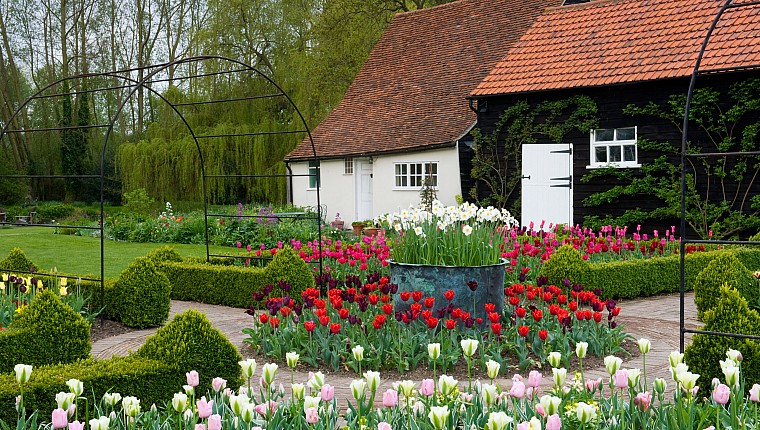Designing a garden with 10,000 tulips

Philippa Burrough, owner of Ulting Wick in Essex, tells us all about “tulip mania”, and how she designs her garden to showcase the 10,000 tulips that bloom there each spring.
When I first started to garden at Ulting Wick in 1995 I was determined to plant a few tulips. As a young child I was taken to the Keukenhoff by my Dutch godmother and the memory of massed tulips had stayed with me so I suppose it was inevitable that these cheerful harbingers of a colourful gardening year would feature somewhere.
As the years have gone by, “tulip mania” has really taken hold and we now plant 10,000 new tulips each year – trying new varieties and colour combinations to ring the changes. This ensures that our many returning loyal visitors can expect a different spring display each year. We usually plant 50 different varieties with some being firm favourites whilst others are trialled in pots the previous year so we can see if they could work in a garden setting the next. As we all know photos in catalogues can be deceptive!

Marcus Harpur
At Ulting Wick we are blessed with a number of wonderful listed wooden barns clad in black tar varnished elm boards – Essex vernacular architecture at its best. I am drawn to rich and saturated coloured tulips as these “bounce” off the black barns whilst white tulips against the black provide a cool contrast in the more muted tones of the White Garden. The centre piece of the garden is the box-edged Old Farmyard beds where 4,000 tulips are planted in dynamic groups and sweeps of tulips underplanted by vibrant wall flowers, through stipa tenuissima and Geranium phaeum Samobor and alongside Tellima grandiflora, a key spring plant for us with its tall acid green foliage and subtle pink flower spikes. These beds are planned in early May for the following spring. We take extensive notes about future colour combinations and can often be seen wandering around holding a single tulip up against perennials looking for a new good pairing. At the end of May we start the unenviable task of removing all these tulips to make way for our late summer tropical plantings.
Close to the Old farmyard beds I have some cutting areas. These do contain tulips each year but never get cut – partly so that the visitors get to enjoy them but also because I much prefer to see the tulips last longer outside than fade quickly in the house!

Marcus Harpur
Away from the barns in other beds, I try to ensure that the colours of emerging perennials are carefully considered in the choice of tulips and their shape. In the kitchen garden we create a unique colour blend of tulips which are planted in huge swathes in raised beds. This year the coppery tones of the beech hedge are reflected in the selection of tulips Amani, Black Jack and City of Vancouver. Elsewhere, we showcase tulips in a more naturalistic way. We are looking forward to seeing 500 of Tulip Pittsburg in the dappled shade of the stream bed amongst such plants as Brunnera macrophylla, Philadephus coronarius aureus, Ophiphogon planiscapus nigrens and Pulmonaria Sissinghurst white.
My top tip for anyone new to tulips is to plant in as large a number as possible whether in a border or in a pot. Dotted around they look mean and are not impactful. We tend to treat most of our tulips as annuals but some such as much loved Ballerina, Jan Reus or the Viridiflora tulips do repeat well and so are left in situ. If planting in pots it is best to start again each year with new tulips, carefully disinfecting the pots and using new potting material each year to avoid virus issues.
Visit Ulting Wick for their tulip opening this April. Find out more here.

















